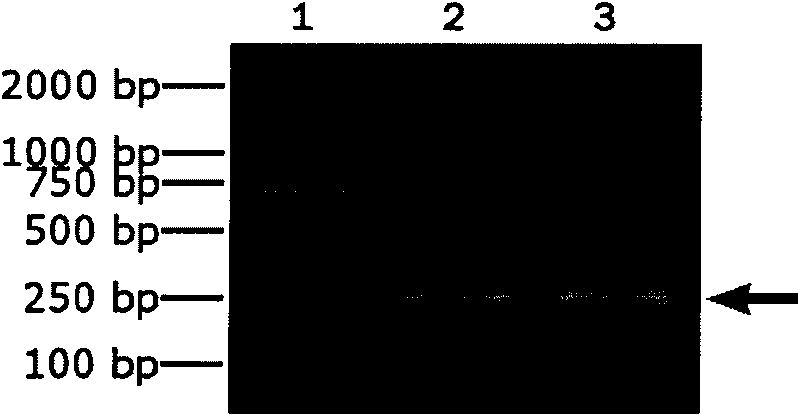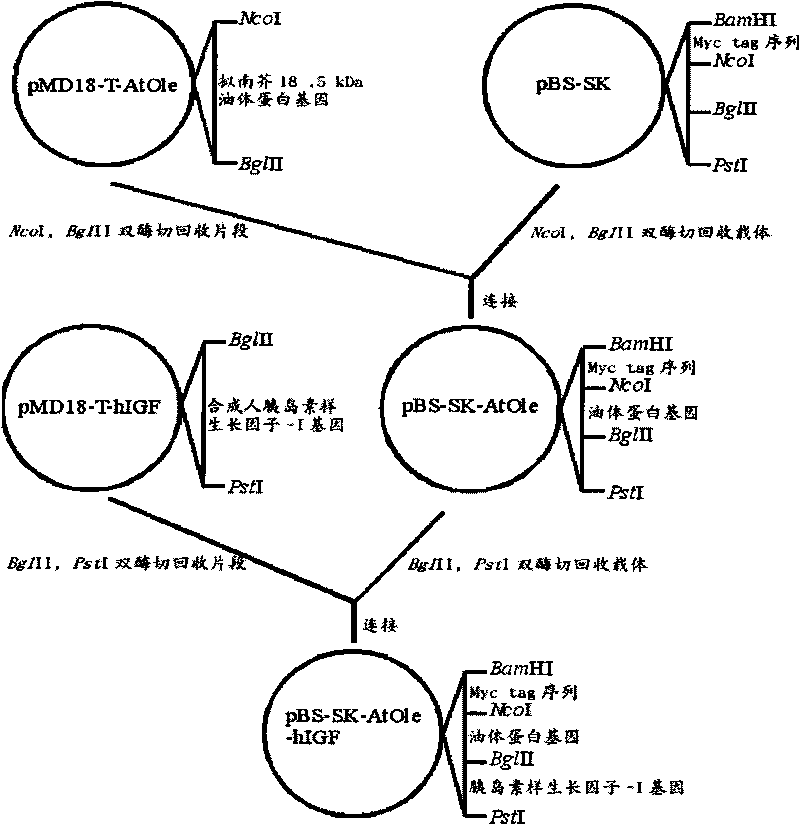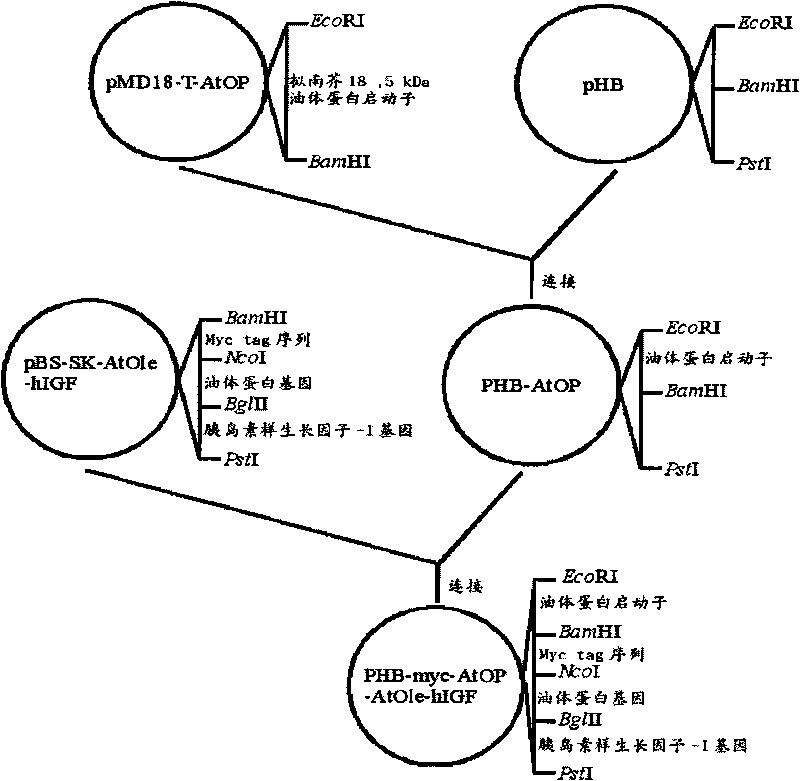Method for producing human insulin-like growth factor-1 by vegetable oil ribosomal protein expression system
A technology for oil body protein and growth factor, applied in the field of genetic engineering, can solve the problems of high production cost and difficulty in forming disulfide bonds, and achieve the effects of avoiding pollution, being beneficial to industrialization, and reducing production costs.
- Summary
- Abstract
- Description
- Claims
- Application Information
AI Technical Summary
Problems solved by technology
Method used
Image
Examples
Embodiment 1
[0042] Preparation and Sequence Determination of Human Insulin-like Growth Factor-I Gene
[0043] According to the hIGF-I protein sequence reported in Genbak, the recognition site of tobacco etch virus protease (TEVP) was designed at its N-terminus, and the hIGF-I gene core optimized by plant codons was designed according to the plant codon usage preference. nucleotide sequence. For the convenience of constructing the vector, restriction enzyme sites Bgl II and Pst I were designed at its two ends respectively. According to the nucleotide sequence, 5 primers were designed and synthesized using the software Primer Premier, each primer was 40-80 bp in length, and the overlap between two adjacent primers was 18-20 bp, and the full-length hIGF was synthesized by a method based on PCR synthesis -I gene.
[0044] The above primers are:
[0045] hIGF-Ia: 5′-AGATCTGAAAACCTTTACTTCCAGGGACCTGAGACCCTCTGTGGAGCA-3′
[0046] hIGF-Ib: 5′-GACCCTCTGTGGAGCAGAACTTGTTGATGCTCTCCAATTCGTGTGTGGAGAC...
Embodiment 2
[0068] Construction of human insulin-like growth factor-I oil body expression vector
[0069] 1. Cloning of Arabidopsis 18.5kDa oil body protein gene
[0070] Primer AtOleF1 (5′-GGAT) was designed according to the published Arabidopsis thaliana 18.5kDa oil body protein gene sequence (Genbak accession number: X62353). CCATGG CGGATACAGCTAGAG-3', the Nco I restriction site is underlined) and AtOleR1 (5'- AGATCT TTAAGTAGTGTGCTGGCCA-3', underlined as Bgl II restriction site), the Arabidopsis thaliana cDNA was used as the template to obtain the Arabidopsis thaliana oil body protein gene coding region by PCR. Reaction conditions: 94°C for 5min, (94°C for 40sec, 59°C for 40sec, 72°C for 1min)×33cycles, 72°C for 8min. The reaction product was separated by 1% agarose gel electrophoresis to obtain a fragment of about 530 bp, which was recovered and ligated into the pMD18-T vector to obtain the vector pMD18-T-AtOle. The sequencing results showed that the obtained fragment was consiste...
Embodiment 3
[0076] Agrobacterium-mediated transformation and screening of Arabidopsis
[0077] 1. Agrobacterium transformation
[0078]The above vector pHB-myc-AtOP-AtOle-hIGF was transformed into Agrobacterium tumefaciens strain GV3101 by freeze-thaw method. Add 5 μL of the plasmid to 200 μL of Agrobacterium GV3101 competent cells, mix well, ice bath for 30 minutes; put it in liquid nitrogen for quick freezing for 5 minutes, quickly take it out and transfer it to a 37°C water bath and incubate for 5 minutes. Add 800 μL of antibiotic-free LB, recover and culture for 3 hours on a shaker at 28°C below 200 rpm; after resuscitation, take 200 μL of bacterial solution and spread it evenly on 25 mg / L rifampicin, 25 mg / L gentamicin and kanamycin. 50mg / L LB plate, 28 ℃ inverted culture for 2 days. Pick well-separated monoclonal colonies and inoculate them in LB liquid medium containing rifampicin 25mg / L, gentamicin 25mg / L and kanamycin 50mg / L and culture overnight at 28°C on a shaker;
[0079] ...
PUM
 Login to View More
Login to View More Abstract
Description
Claims
Application Information
 Login to View More
Login to View More - R&D
- Intellectual Property
- Life Sciences
- Materials
- Tech Scout
- Unparalleled Data Quality
- Higher Quality Content
- 60% Fewer Hallucinations
Browse by: Latest US Patents, China's latest patents, Technical Efficacy Thesaurus, Application Domain, Technology Topic, Popular Technical Reports.
© 2025 PatSnap. All rights reserved.Legal|Privacy policy|Modern Slavery Act Transparency Statement|Sitemap|About US| Contact US: help@patsnap.com



